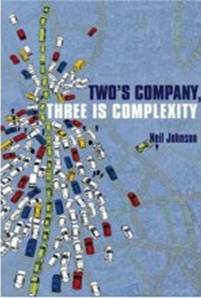|

Product Description
What do traffic jams, stock market crashes, and wars have in common? They can all be explained
by complexity, an unsolved puzzle which is the most important scientific development since general relativity, and considered
by many to be the 'Science of Sciences'. In Two's Company, Three is Complexity, Neil Johnson draws on his experience as a
leading researcher in the field to explore the surprising ways in which order eventually emerges from the interaction of all
things. Relevant across the whole breadth of social studies and science from pubs to plants, Johnson utilizes a wealth of
real-life examples as he leads us on a brilliantly entertaining romp through chaos, game theory, economics, and even jazz,
ultimately proving that complexity lies at the very heart of the Universe itself. The sheer scope and interdisciplinary nature
of the subject means that those with backgrounds in physics, biology, engineering, computer science, economics, sociology,
politics, business, or mathematics will appreciate the book's relevance to, and illumination of, their own field of interest.
Lucidly written, this is the first publication to deal with complexity as a self-contained subject in its own right, and will
be an indispensable reference for anyone seeking to step back and understand how order always emerges from the patterns and
processes of every day life.
|
|
p.3-5 Complexity Science can be seen as the study of the phenomenon which emerge
from a collection of interacting objects...The Holy Grail of Complexity Science is to understand, predict and control
such emergent phenomena
p.13-15 Most Complexity researchers would agree that any candidate Complex System should have most or all
of the following ingredients: The system contains a collection of many interacting objects or "agents"... These objects'
behavior is affected by memory or "feedback". This means that something from the past affects something in the present,
or that something going on at one location affects what is happening at another... The objects can adapt their strategies
according to their history... The system is typically "open". This means that the system can be influenced by its environment...
The system appears to be "alive". The system evolves in a highly non-trivial and often complicated way, driven
by an ecology of agents who interact and adapt under the influence of feedback... The system exhibits emergent phenomena
which are generally surprising, and may be extreme. In scientific terminology, the system is far from equilibrium...
The emergent phenomena typically arise in the absence of any sort of "invisible hand" or central controller. In other
words, a Complex system can evolve in a complicated way all by itself. For this reason, Complex Systems are often regarded
as being more than the sum of their parts... The system shows a complicated mix of ordered and disordered behavior... More
generally, all Complex Systems seem to be able to move between order and disorder of their own accord.
p.17 Complexity focuses on what new phenomena can emerge from a collection of relatively simple
components. In other words, Complexity looks at the complicated and surprising things which can emerge from the interaction
of a collection of objects which themselves may be rather simple... Complexity therefore represents a slap in the
face for traditional reductionist approaches to understanding the world.
p.19,21 One of the tell-tale characteristics that a particular system... is complex is that it exhibits
emergent phenomena which are surprising, extreme and self-generated... a Complex System can move freely between disorder
and order, and back again, and can therefore be said to exhibit "pockets of order".... These pockets of order can arise in
both time and space.
p.71-72 Why is the competition for resources so important in producing Complexity in real-world systems?
... Most real-world systems of interest do feature some kind of limited resource - and the individual objects
in the system will typically fight tooth and nail to get hold of it... the spontaneous formation of... self-organized,
collective phenomena is a true signature of complexity.
|
 |
|
|
 |
|
|
 |
|
|
|

